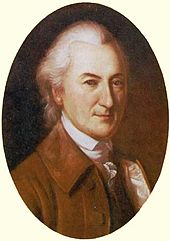Pennsylvania
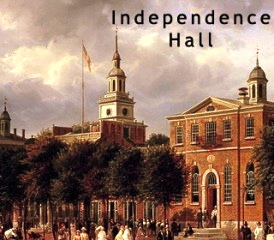
William Penn’s Holy Experiment of Philadelphia
He was arrested and imprisoned in the Tower of London eight months for being a Quaker, but later King Charles II gave him land in America as repayment of a debt owed to his father. On this land he started a colony and invited persecuted Christians of Europe to join his “holy experiment” of religious toleration. Find us on Roku! http://thestoryofliberty.intuitwebsit…
 Timeline of Pennsylvania: 1600’s
Timeline of Pennsylvania: 1600’s
- (1608) Captain John Smith of Virginia visited Susquehannock Indians
- (1609) Henry Hudson claimed land for Dutch
- (1615 – 1616) Explorers Etienne Brule of France, Cornelius Hendricksen of The Netherlands explored part of Pennsylvania; Brule lived among Indians
- (1632) Brule killed by Indians
- (1643) Swedes established first permanent settlement in Pennsylvania on Tinicum Island
- (1655) Dutch seized Swedish settlements
- (1664) British captured Dutch colonies in name of Duke of York
- (1676) Duke of York’s Laws introduced for English laws, civil government
- (1681) William Penn received royal grant of Pennsylvania from King Charles II
- (1682) Duke of York deeded lands to William Penn; Penn arrived in Pennsylvania, laid out Philadelphia; created three original counties; first Assembly held, united Delaware counties with Pennsylvania, adopted Great Law
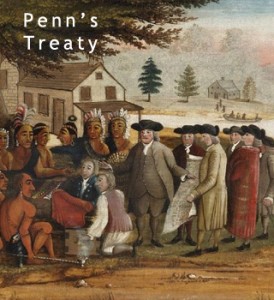 (1683) Penn signed friendship treaty with Lenni Lenape Indians; Mennonite families arrived from Germany, settled Germantown
(1683) Penn signed friendship treaty with Lenni Lenape Indians; Mennonite families arrived from Germany, settled Germantown- (1684) Congress named William Penn and wife, Hannah Callowhill Penn, third, fourth honorary citizens of U. S.
- (1686) Penn purchased land along Lehigh River from Lenape Indians
- (1688) Germantown Quakers adopted first antislavery resolution in America
1700’s
- (1701) Penn presented Charter of Privileges for Province of Pennsylvania; established religious freedom, tolerance. Remained as constitution until American Revolution
- (1712) Pennsylvania Assembly banned importing of slaves
- (1720) First Catholic congregation organized in Philadelphia
- (1731) Benjamin Franklin opened first U.S. library
- (1737) Pennsylvania took over large portion of native American land, (Walking Purchase)
- (1744) Benjamin Franklin established American Philosophical Society in Philadelphia
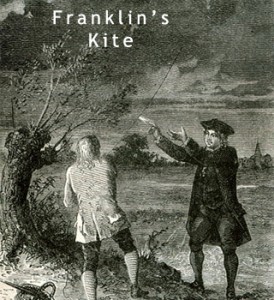 (1750) Benjamin Franklin used kite to establish that lightning is a form of electricity
(1750) Benjamin Franklin used kite to establish that lightning is a form of electricity- (1752) Benjamin Franklin tested lightning rod; Liberty Bell arrived in Philadelphia
- (1754) French and Indian War began; George Washington claimed first victory at Laurel Mountain; Lenape Indians attacked Gnadenhutten Mission, killed 11 white people
- (1754 – 1763) French and Indian War
- (1755) Gen. Graddock’s British troops slaughtered near Monongahela
- (1758) Gen. John Forbes led British forces in capture of Fort Duquesne
- (1763) Indians rose up against British colonies
- (1767) Boundary between Maryland, Pennsylvania established, named Mason-Dixon line
- (1773) Philadelphia refused entry to tea ships
- (1774) First Continental Congress met secretly in Philadelphia; protested British measures, taxes
- (1775) Second Continental Congress met, George Washington named supreme commander; postal system for colonies established, Benjamin Franklin first postmaster general
- (1776) A committee of the Second Continental Congress consisting of John Adams of Massachusetts, Benjamin Franklin of Pennsylvania, Thomas Jefferson of Virginia, Robert R. Livingston of New York, and Roger Sherman of Connecticut (the “Committee of Five”) was formed to draft a declaration of independence from Britain. The resulting Declaration of Independence was signed in Philadelphia; Pennsylvania established commonwealth; Betsy Ross sewed first American flag
- (1777 – 1778) British troops occupied Philadelphia; General George Washington (America’s first President) and his bloodied and battle-worn Continental Army wintered at Valley Forge, Pennsylvania. This tactical decision provided a much-needed rest and retraining period, and after six months in camp his highly-motivated and revitalized army marched out of Valley Forge to defeat the British in battle after battle.
- (1777) Congress of United States left Philadelphia, moved to York
- (1780) Pennsylvania first state to abolish slavery
- (1787) Pennsylvania second state to ratify U. S. Consitutition
- (1790 – 1800) Philadelphia capital of U. S.
- (1792) Philadelphia shoemakers formed first union
- (1793) Yellow fever epidemic in Philadelphia killed about 2,000
- (1794) Whiskey Rebellion occurred – protest against taxes on distilled spirits(1780) Pennsylvania first state to abolish slavery(1787) Pennsylvania second state to ratify U. S. Consitutition(1790 – 1800) Philadelphia capital of U. S.(1792) Philadelphia shoemakers formed first union
(1793) Yellow fever epidemic in Philadelphia killed about 2,000
(1794) Whiskey Rebellion occurred – protest against taxes on distilled spirits
1800’s
(1812) Harrisburg became state capital
(1835) Liberty Bell cracked while being tolled for Chief Justice John Marshall
(1840’s) Chain Gang, earliest Mummers Club, founded
(1845) Fire in Pittsburgh damaged over 1,000 buildings; George Dallas became U.S. Vice President
(1846) Liberty Bell rang for last time in commemoration of George Washington’s birthday
(1851) Christiana riots occurred when Maryland slave owner tried to recapture salves in southeastern Pennsylvania
(1856) Republican party held first national convention in Philadelphia
(1857) James Buchanan became U.S. President
(1859) Oil discovered at Titusville
(1861 – 1865) Civil War
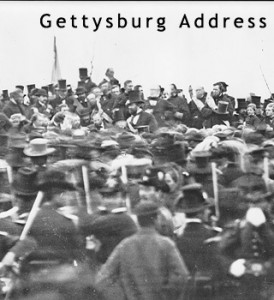 (1863) Two-day Battle of Gettysburg was turning point in war; President Lincoln delivered Gettysburg Address; dedicated national cemetery
(1863) Two-day Battle of Gettysburg was turning point in war; President Lincoln delivered Gettysburg Address; dedicated national cemetery(1864) Confederate troops attacked Chambersburg; burned town
(1869) Coal mine fire killed 110 miners; Philadelphia garment workers founded national labor union, Knights of Labor
(1872) First long-distance natural gas pipeline in U.S. completed, five miles from Newton Wells to Titusville
(1876) Thomas Edison demonstrated telephone at Centennial Exposition in Philadelphia
(1877) First national strike in U.S. began in Pittsburgh against Pennsylvania Railroad
(1889) South Fork Dam burst, town of Johnstown destroyed, over 2000 deaths
(1894) Milton Hershey founded Hershey Foods and town of Hershey
(1897) Fire destroyed state capitol in Harrisburg; coal miners went on strike, police shot 20 people
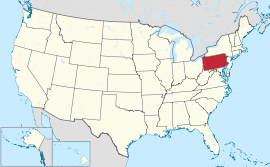 Pennsylvania (
Pennsylvania (![]() i/ˌpɛnsɨlˈveɪnjə/), officially the Commonwealth of Pennsylvania, is a US state that is located in the Northeastern and Mid-Atlantic regions of the United States, and the Great Lakes Region. The state borders Delaware to the southeast, Maryland to the south, West Virginia to the southwest, Ohio to the west, Ontario, Canada to the northwest, New York to the north, and New Jersey to the east.
i/ˌpɛnsɨlˈveɪnjə/), officially the Commonwealth of Pennsylvania, is a US state that is located in the Northeastern and Mid-Atlantic regions of the United States, and the Great Lakes Region. The state borders Delaware to the southeast, Maryland to the south, West Virginia to the southwest, Ohio to the west, Ontario, Canada to the northwest, New York to the north, and New Jersey to the east.
Pennsylvania is the 33rd most extensive, the 6th most populous, and the 9th most densely populated of the 50 United States. The state’s four most populous cities are Philadelphia, Pittsburgh, Allentown, and Erie. The state capital is Harrisburg. Pennsylvania has 51 miles (82 km) of shoreline along Lake Erie and 57 miles (92 km) of shoreline along the Delaware Estuary.
Before the Commonwealth was settled by Europeans, the area was home to the Delaware (also known as Lenni Lenape), Susquehannock, Iroquois, Eriez, Shawnee, and other American Indian Nations. Both the Dutch and the English claimed both sides of the Delaware River as part of their colonial lands in America. The Dutch were the first to take possession, which has impact on the history of Pennsylvania.
By June 3, 1631, the Dutch had started up the DelMarVa Peninsula by establishing the Zwaanendael Colony on the site of present day Lewes, Delaware. In 1638, Sweden heated up the issue by establishing the New Sweden Colony, centered on Fort Christina, on the site of present day Wilmington, Delaware. New Sweden claimed and, for the most part, controlled the lower Delaware River region (Parts of present Delaware, New Jersey and Pennsylvania) but settled few colonists there.
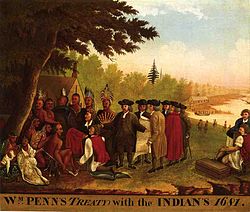 Penn’s Treaty with the Indians, by Edward Hicks.
Penn’s Treaty with the Indians, by Edward Hicks.
On March 12, 1664, King Charles II of England gave James, Duke of York a grant that included all of the lands included in the original Virginia Company of Plymouth Grant as well as other lands. This grant was – again – in conflict with the Dutch claim for New Netherland, which included parts of today’s Pennsylvania.
On June 24, 1664, The Duke of York sold the portion of his large grant that included present day New Jersey to John Berkeley and George Carteret for a proprietary colony. As of yet, the land was not in British possession, but the sale boxed in the portion of New Netherland on the West side of the Delaware River. The British conquest of New Netherland was commenced on August 29, 1664, when New Amsterdam was coerced to surrender, facing the cannons on British ships in New York Harbor. This conquest continued, and was completed in October 1664, when the British captured Fort Casimir in what today is New Castle, Delaware.
The Peace of Breda between England, France and the Netherlands confirmed the British conquest on July 21, 1667, although there were temporary reversions.
On September 12, 1672, as part of the Third Anglo—Dutch War, the Dutch re-conquered New York Colony/New Amsterdam, the Dutch established three County Courts which went on to become original Counties in present day Delaware and Pennsylvania. The one that later transferred to Pennsylvania was Upland. This was partially reversed on February 9, 1674, when the Treaty of Westminster ended the Third Anglo-Dutch War, and reverted all political situations to the status quo ante bellum. The British retained the Dutch Counties with their Dutch names. By June 11, 1674, New York reasserted control over the outlying colonies, including Upland, but the names started to be changed to British names by November 11, 1674. Upland was partitioned on November 12, 1674, producing the general outline of the current border between Pennsylvania and Delaware.
On February 28, 1681, Charles II granted a land charter to William Penn to repay a debt of £16,000 (around £2,100,000 in 2008, adjusting for retail inflation) owed to William’s father, Admiral William Penn. This was one of the largest land grants to an individual in history. It was called Pennsylvania. William Penn, who wanted it called New Wales or Sylvania, was embarrassed at the change, fearing that people would think he had named it after himself, but King Charles would not rename the grant. Penn established a government with two innovations that were much copied in the New World: the county commission and freedom of religious conviction.
What had been Upland on what became the Pennsylvania side of the Pennsylvania-Delaware Border was renamed as Chester County when Pennsylvania instituted their colonial governments on March 4, 1681. The Quaker leader William Penn had signed a peace treaty with Tammany, leader of the Delaware tribe, beginning a long period of friendly relations between the Quakers and the Indians. Additional treaties between Quakers and other tribes followed. The treaty of William Penn was never violated.
18th century
Between 1730 and when it was shut down by Parliament with the Currency Act of 1764, the Pennsylvania Colony made its own paper money to account for the shortage of actual gold and silver. The paper money was called Colonial Scrip. The Colony issued “bills of credit”, which were as good as gold or silver coins because of their legal tender status. Since they were issued by the government and not a banking institution, it was an interest-free proposition, largely defraying the expense of the government and therefore taxation of the people. It also promoted general employment and prosperity, since the Government used discretion and did not issue too much to inflate the currency. Benjamin Franklin had a hand in creating this currency, of which he said its utility was never to be disputed, and it also met with the “cautious approval” of Adam Smith.
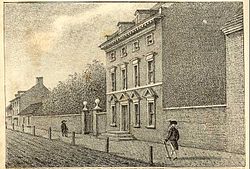 President’s House, Philadelphia. The Masters-Penn mansion housed Pennsylvania’s governor in the early 1770s. It later served as the presidential mansion of George Washington and John Adams, 1790–1800, while Philadelphia was the temporary national capital.
President’s House, Philadelphia. The Masters-Penn mansion housed Pennsylvania’s governor in the early 1770s. It later served as the presidential mansion of George Washington and John Adams, 1790–1800, while Philadelphia was the temporary national capital.
After the Stamp Act Congress of 1765, Delegate John Dickinson of Philadelphia, Pennsylvania, wrote the Declaration of Rights and Grievances. The Congress was the first meeting of the thirteen colonies, called at the request of the Massachusetts Assembly, but only nine colonies sent delegates. Dickinson then wrote Letters from a Farmer in Pennsylvania, To the Inhabitants of the British Colonies, which were published in the Pennsylvania Chronicle between December 2, 1767, and February 15, 1768.
When the Founding Fathers of the United States convened in Philadelphia in 1774, 12 colonies sent representatives to the First Continental Congress. The Second Continental Congress, which also met in Philadelphia (in May, 1775), drew up and signed the Declaration of Independence in Philadelphia, but when that city was captured by the British, the Continental Congress escaped westward, meeting at the Lancaster courthouse on Saturday, September 27, 1777, and then to York. There they drew up the Articles of Confederation that formed 13 independent colonies into a new nation. Later, the Constitution was written, and Philadelphia was once again chosen to be cradle to the new American Nation.
Pennsylvania became the second state to ratify the U.S. Constitution on December 12, 1787, five days after Delaware became the first.

